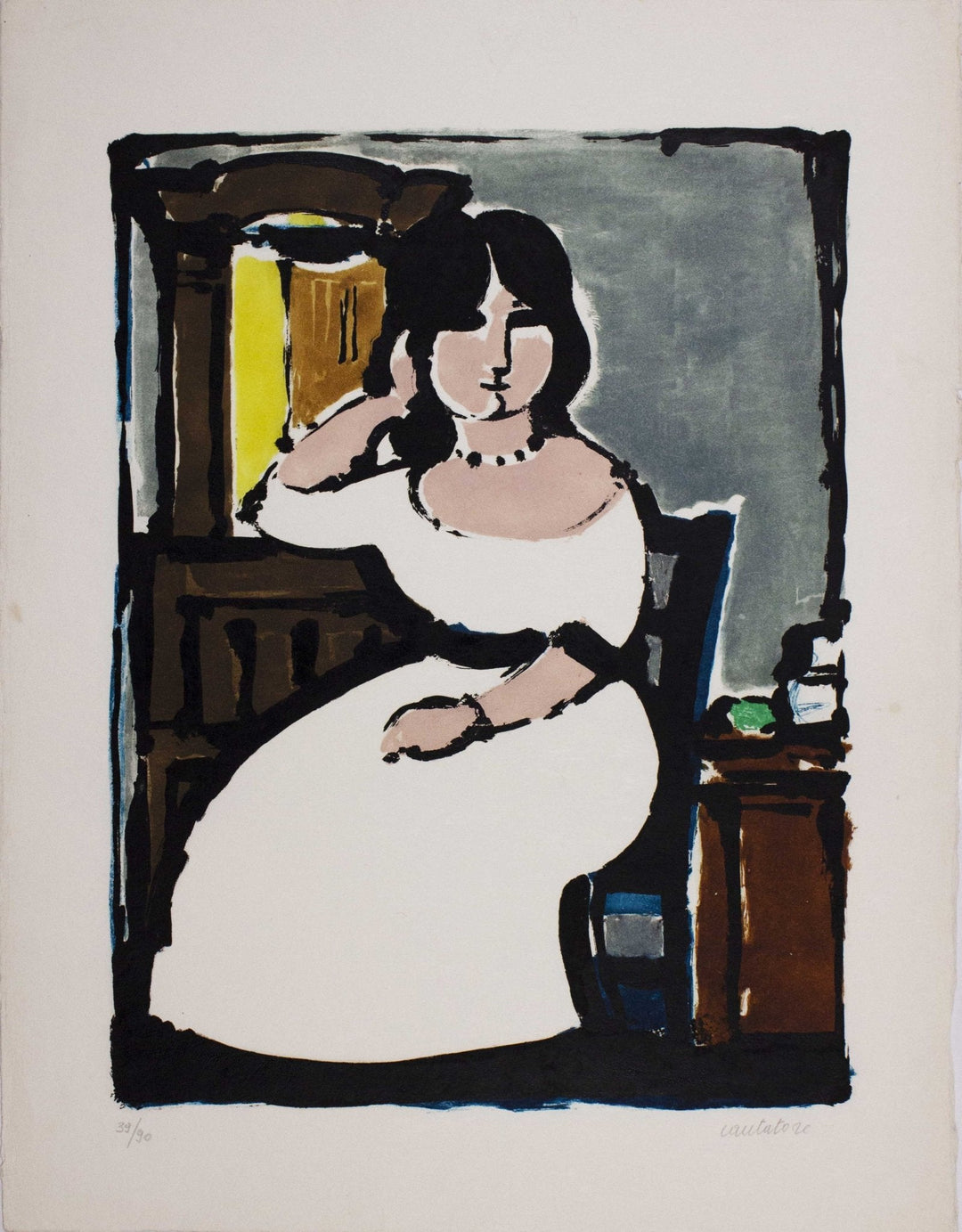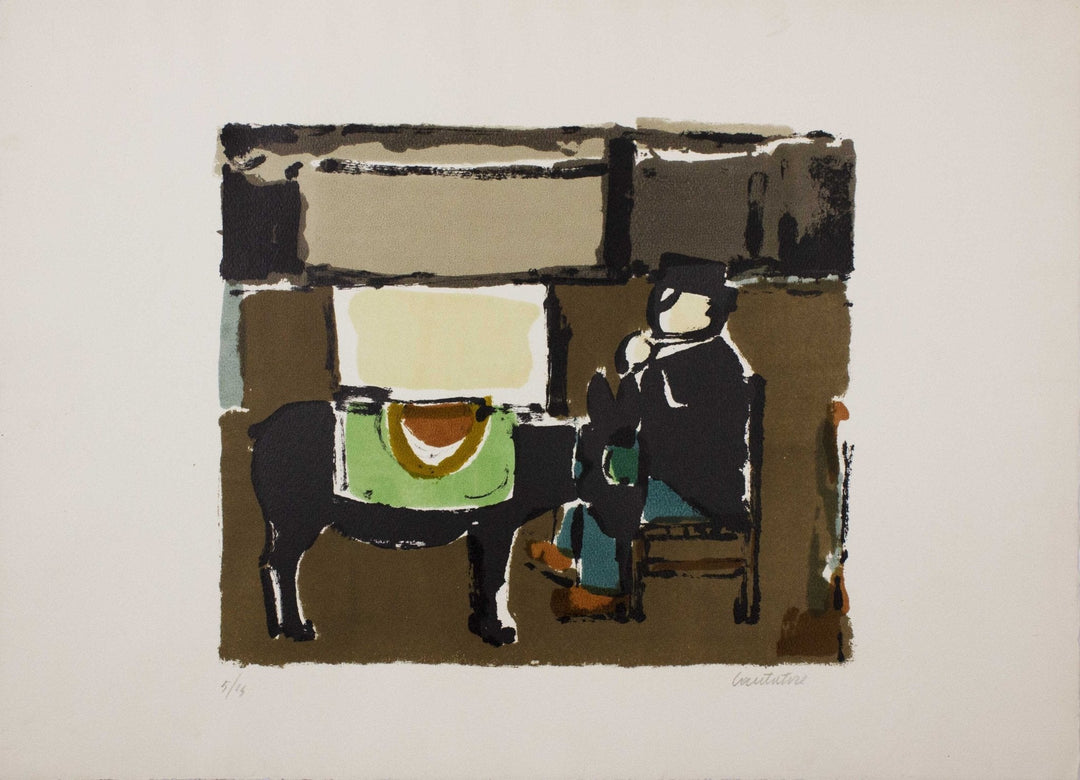Domenico Cantatore
Domenico Cantatore was born on March 16, 1906, in Ruvo di Puglia, the youngest of eight siblings, in a family context marked by poverty. His childhood was harsh, characterized by hardships that, however, could not extinguish his innate artistic sensitivity. At only eighteen years old, thanks to the meeting with Benedetto Nardi, he began working as a room decorator: an experience that introduced him to the world of painting, definitively igniting his passion for art.
In 1922 he left Puglia to move first to Rome, where he joined his brother Giuseppe Cantatore, also a painter, and later to Milan in 1925. It was precisely in the Lombard capital that he began to paint seriously and to frequent cultural circles linked to the artistic and literary movement "Corrente". His first solo exhibition was held in 1930 at the Galleria d'Arte Moderna in Milan, marking the beginning of his public career.
In Milan, he established important friendships with prominent figures of Italian culture, such as Carlo Carrà, Leonardo Sinisgalli, Alfonso Gatto, the Armenian poet Hrand Nazariantz, and the future Nobel Prize winner Salvatore Quasimodo. Among all, however, he was particularly close to Raffaele Carrieri, also from Puglia. It was thanks to a friend that, in 1932, Cantatore moved to Paris, where he closely encountered the art of the Impressionists and the artworks of Picasso, Modigliani, Matisse, and the Fauves. In the French capital, he forged relationships with Italian artists such as Carlo Levi and Filippo de Pisis.
The Parisian stay was fundamental for his stylistic evolution, although only a notebook and some etchings remain from the production of those years. Returning to Milan in 1934, he exhibited the drawings made in Paris at the Galleria del Milione, gaining increasing critical recognition.
In 1940, by clear reputation, he was assigned the chair of Figure at the Accademia di Brera, succeeding Aldo Carpi. He taught there until 1976, when he handed over the position to his student Natale Addamiano. His teaching was appreciated for the ability to combine academic rigor and poetic inspiration, qualities that made him very beloved by students.
After the war, the meeting with Giorgio Morandi in 1948 further influenced his pictorial language, pushing him towards greater sobriety and adherence to reality. In the same period, he participated in important artistic events such as the Premio Bergamo, the Venice Biennale, and the Rome Quadriennale, where in 1955 he also became part of the invitation commission.
In 1956 he traveled to Spain, an experience that strengthened his attraction to the warm and luminous colors of the Mediterranean. From that moment, and for all the following years until the 1980s, Southern Italy became the absolute protagonist of his painting: hilly landscapes, fiery sunsets, religious rites, confraternities, and human figures sculpted by fatigue and devotion.
The female figure played a central role in his production, often depicted with elegance and spirituality. His "odalisque", a sensual and mysterious woman, became one of the most beloved and recognizable subjects of his art. At the same time, he did not neglect the literary dimension: he wrote stories and memoirs such as The Room Painter (1944) and Return to the Village (1966), artworks that testify to his deep connection with his Apulian roots.
In 1965 Ruvo di Puglia dedicated a major event in his honor, which Quasimodo also attended. During the event, he received a gold medal and documentaries about his life were screened. Meanwhile, he continued to exhibit in Italy and abroad, cultivating friendships with artists linked to Fauvism, and regularly visiting places like Montefiore dell’Aso in the Marche, a source of continuous inspiration. As a sign of gratitude towards that village, he donated to the Municipality a precious collection of graphic artworks, now housed at the San Francesco Museum Complex.
Domenico Cantatore died in Paris on May 22, 1998, while visiting the places of his youth. He was 92 years old. His artistic legacy includes paintings, writings, but also a vast and valuable production of author graphics, which places him among the Italian masters of the twentieth century.
Domenico Cantatore artworks
The painting work of Domenico Cantatore stands out for the harmony between form and color, and for a poetics that restores dignity and beauty to the everyday scenes of Southern Italy. His canvases tell a reality often forgotten: women in black, men bent by work, religious processions, sunny landscapes, and intimate interiors. His subjects, stylized but full of humanity, move in essential spaces, suspended between memory and symbol.
Cantatore's style went through different phases but maintained an expressive coherence based on a personal use of line and a warm and luminous palette. Strongly influenced by Mediterranean visual culture and French masters, he was able to blend modernity and tradition, becoming one of the deepest interpreters of twentieth-century Italian painting.
He worked on various supports and techniques, also engaging in large mural decorations, illustrations, engravings, and frescoes. Many of his artworks are part of public and private collections, exhibited in museums, foundations, and galleries throughout Europe.
Domenico Cantatore lithographs
A particularly important chapter in Domenico Cantatore's career is dedicated to author graphics. The artist skillfully engaged in techniques such as etching, aquatint, drypoint, and especially lithography. The latter allowed him to explore with freedom and elegance his most iconic figure: the odalisque.
The lithographs dedicated to odalisques represent a peak of his poetic imagination. In these artworks, Cantatore depicts reclining female figures, often nude or semi-clothed, immersed in a dreamlike and suspended atmosphere. The soft lines, sinuous contours, and refined graphic stroke convey a calm sensuality, never ostentatious, rich in mystery and spirituality.
Cantatore's odalisques are not just women but archetypes. They recall pagan deities, secular Madonnas, or simply silent muses that seem to emerge from a Southern dream. The skillful use of color in the lithographs, sometimes limited to a few tones, enhances the volumes of the bodies and the compositional balance, expressing a sense of still grace.
In these artworks, the bond between artist and technique is evident: lithography becomes not only an expressive medium but an autonomous language, capable of conveying all the emotional nuances of his art. The odalisques remain among the most appreciated and collected subjects of the entire Cantatore production, a testament to his ability to combine drawing with classical sensuality and the Mediterranean vision of the figure.














